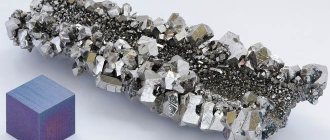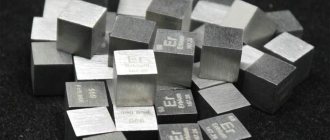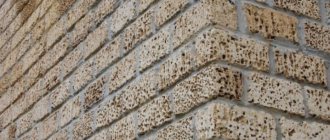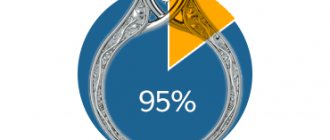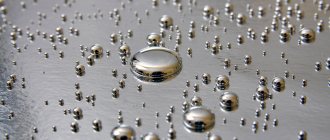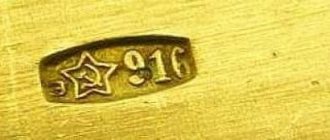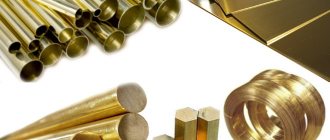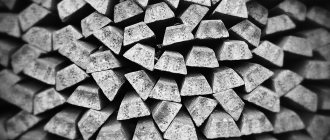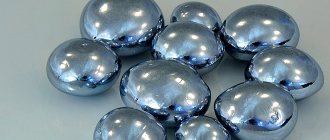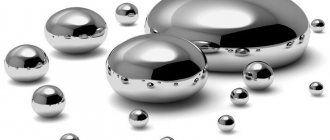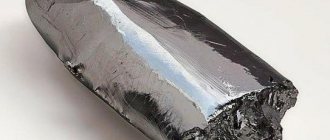Non-ferrous metals have been mined in Saxony since ancient times. Often, miners mined seemingly silver ore, but were unable to smelt the silver. And when smelted, the ore released gas, which poisoned the workers. The miners called this “unclean” ore “kobold.” It was believed that evil spirits of the dungeons (kobolds) harm miners, hide good ore and slip in poisonous ones.
Hence the origin of the name - cobalt. In this case, nickel and our hero are siblings. Both took their names from pagan mountain spirits.
General information:
| 100 | General information | |
| 101 | Name | Cobalt |
| 102 | Former name | |
| 103 | Latin name | Cobaltum |
| 104 | English name | Cobalt |
| 105 | Symbol | Co |
| 106 | Atomic number (number in table) | 27 |
| 107 | Type | Metal |
| 108 | Group | Transitional, heavy metal |
| 109 | Open | Georg Brandt, Sweden, 1735 |
| 110 | Opening year | 1735 |
| 111 | Appearance, etc. | Hard, shiny, silvery-white, slightly yellowish metal with a pinkish or bluish tint |
| 112 | Origin | Natural material |
| 113 | Modifications | |
| 114 | Allotropic modifications | 2 allotropic modifications of cobalt: - α-cobalt with a hexagonal close-packed lattice, - β-cobalt with a cubic face-centered lattice. |
| 115 | Temperature and other conditions for the transition of allotropic modifications into each other* | |
| 116 | Bose-Einstein condensate | |
| 117 | 2D materials | |
| 118 | Content in the atmosphere and air (by mass) | 0 % |
| 119 | Content in the earth's crust (by mass) | 0,003 % |
| 120 | Content in seas and oceans (by mass) | 8,0·10-8 % |
| 121 | Content in the Universe and space (by mass) | 0,0003 % |
| 122 | Abundance in the Sun (by mass) | 0,0004 % |
| 123 | Content in meteorites (by mass) | 0,059 % |
| 124 | Content in the human body (by weight) | 2,0·10-6 % |
Metal properties
Cobalt is element number 27 on the periodic table. It is classified as a metal and has a white or yellowish silver color. Has a bluish or pinkish tint.
Physical properties of metal:
- density 8.9 g/cm³;
- melting point 1495°C;
- boils at 2870 degrees Celsius;
Cobalt is ferromagnetic, like its two neighbors on the periodic table - iron and nickel.
We recommend: LITHIUM - in space, on earth, under water
The chemical properties of a metal are determined by its oxidation states - +2, +3, 0.
Cold concentrated nitric acid passivates Co.
Alkalis react with aqueous solutions of salts, resulting in the formation of Co(OH)2 hydroxide.
Properties of the atomCobalt / Cobaltum (Co), 27 - Name, symbol, number |
| 58.933194(4) a. e.m. (g/mol) - Atomic mass (molar mass) |
| [Ar] 3d7 4s2 — Electron configuration |
| 125 pm - Atomic radius |
Chemical properties116 pm - Covalent radius |
| (+3e) 63 (+2e) 72 pm - Ion radius |
| 1.88 (Pauling scale) - Electronegativity |
| E0(Co2+/Co) = −0.277 V — Electrode potential |
| 3, 2, 0, −1 — Oxidation states |
| 758.1 (7.86) kJ/mol (eV) - Ionization energy (first electron) |
Thermodynamic properties of a simple substance8.9 g/cm³ — Density (at no.) |
| 1768 K - Melting point |
| 3143 K - Boiling point |
| 15.48 kJ/mol - Spec. heat of fusion |
| 389.1 kJ/mol - Spec. heat of vaporization |
| 24.8[1] J/(K mol) — Molar heat capacity |
| 6.7 cm³/mol - Molar volume |
Crystal lattice of a simple substancehexagonal - Lattice structure |
| a=2.505 c=4.089 Å — Lattice parameters |
| 1.632 — Ratio c/a |
| 385 K — Debye temperature |
Other characteristics(300 K) 100 W/(m K) - Thermal conductivity |
| 7440-48-4 - CAS number |
Water-soluble cobalt salts give water a pink color. Dissolved in acetone, these salts turn the solution blue.
Who found the “harmful spirit”
The story of the discovery is simple. Georg Brandt, a Swedish chemist and mineralogist (and also the head of the Royal Swedish Mint) loved arsenic. Not in a gastronomic sense, but as a scientist. But in the course of researching his favorite element, the scientist found methods for producing certain metals and developed methods for producing basic acids (sulfuric, nitric, hydrochloric). He also determined what kind of harmful spirit was preventing miners from extracting silver.
The ore contained a previously unknown element; Brandt called it cobalt. The chemist also found out that the salts of the found metal paint the glass a delightful blue color.
Informative: in ancient times, glass and blue smalt were made in the centers of civilizations (Egypt, Babylon).
Martin Ruland, a German physician and alchemist who worked at the court of Emperor Rudolf II, wrote in his Alchemical Lexicon:
“Cobalt (Koboltum, Kobaltum) or collet (Colletum) ... black matter, slightly similar in color to ash, which can be forged and cast, it does not have a metallic sheen, and is a harmful suspension that carries away (when melted) good ore." Obviously, we are talking about the metal cobalt here.
Deposits of cobalt-containing ores
In nature, finding such ores does not seem to be a problem. Geologists count more than 130 cobalt-containing minerals. The question is how much metal the ore contains.
There are only about 40 actual cobalt minerals.
- Skutterite. Co content up to 30%.
- Safflorite-löllingite. Cobalt in ore up to 29%.
- Arsenopyrite-alloclasite. It contains up to 35% of the desired metal
- Cobaltine-gersdorffite with Co content up to 35%.
But most cobalt-containing metal ores contain up to 3%.
Cobalt is mined from sulfur copper-nickel, oxidized cobalt-copper, silicate-oxide nickel deposits.
Being in nature
The native metal cobalt is not found on the planet. The form found in nature is ore or minerals.
There are three dozen of them: carolite, cobaltine, smaltite, spherocobaltite, and others.
The mass content of the metal cobalt in the earth's crust is 4x10-3%. Sea water is seven orders of magnitude poorer (10 million times).
Chemical properties of cobalt:
| 300 | Chemical properties | |
| 301 | Oxidation states | -3, -1, 0, +1, +2 , +3 , +4, +5 |
| 302 | Valence | II, III |
| 303 | Electronegativity | 1.88 (Pauling scale) |
| 304 | Ionization energy (first electron) | 760.4 kJ/mol (7.88101 (12) eV) |
| 305 | Electrode potential | Co2+ + 2e— → Co, Eo = -0.277 V, Co3+ + e— → Co2+, Eo = +1.808 V, Co3+ + 3e— → Co, Eo = +0.4 V |
| 306 | Electron affinity energy of an atom | 63.7 kJ/mol |
Valence electrons of cobalt
The number of valence electrons in a cobalt atom is 9.
Below are their quantum numbers (N - principal, L - orbital, M - magnetic, S - spin)
OrbitalNLMS
| s | 4 | 0 | 0 | +1/2 |
| s | 4 | 0 | 0 | -1/2 |
| d | 3 | 2 | -2 | +1/2 |
| d | 3 | 2 | -1 | +1/2 |
| d | 3 | 2 | 0 | +1/2 |
| d | 3 | 2 | 1 | +1/2 |
| d | 3 | 2 | 2 | +1/2 |
| d | 3 | 2 | -2 | -1/2 |
| d | 3 | 2 | -1 | -1/2 |
Oxidation states that cobalt can exhibit: +1, +2, +3, +4, +5
Cobalt ions
5+Co 4+Co
Co 3+2+Co 1+Co 0Co 1-Co
3+Valency Co
Cobalt atoms in compounds exhibit valence V, IV, III, II, I.
The valence of cobalt characterizes the ability of the Co atom to form chemical bonds. Valence follows from the structure of the electron shell of the atom; electrons involved in the formation of chemical compounds are called valence electrons. A more extensive definition of valence is:
The number of chemical bonds by which a given atom is connected to other atoms
Valence has no sign.
Quantum numbers Co 3+
Quantum numbers are determined by the last electron in the configuration; for the Co ion these numbers have the value N = 3, L = 2, Ml = 0, Ms = ½
Oxides
- In air, cobalt oxidizes at temperatures above 300 °C.
- Cobalt oxide, stable at room temperature, consists of a mixture of oxides CoO and Co2O3, so in reference books you can find the gross formula Co3O4.
- At high temperatures, the α-form or β-form of CoO oxide can be obtained
- All cobalt oxides are reduced with hydrogen. Co3O4 + 4H2 → 3Co + 4H2O.
- Cobalt (II) oxide can be obtained by calcining cobalt (II) compounds, for example: 2Co(OH)2 + O2 → Co2O3 + H2O.
Other connections
- When heated, cobalt reacts with halogens, and cobalt (III) compounds are formed only with fluorine. Co + 3F → CoF3, but, Co + 2Cl → CoCl2
- With sulfur, cobalt forms 2 different modifications of CoS. Silver-gray α-form (when powders are fused) and black β-form (precipitates from solutions).
- When CoS is heated in an atmosphere of hydrogen sulfide, the complex sulfide Co9S8 is obtained
- With other oxidizing elements such as carbon, phosphorus, nitrogen, selenium, silicon, boron. cobalt also forms complex compounds, which are mixtures where cobalt is present with oxidation states 1, 2, 3.
- Cobalt is able to dissolve hydrogen without forming chemical compounds. Two stoichiometric cobalt hydrides CoH2 and CoH were synthesized indirectly.
- Solutions of cobalt salts CoSO4, CoCl2, Co(NO3)2 give the water a pale pink color. Solutions of cobalt salts in alcohols are dark blue. Many cobalt salts are insoluble.
- Cobalt creates complex compounds. Most often based on ammonia.
The most stable complexes are yellow luteosalts [Co(NH3)6]3+ and red or pink roseosalts [Co(NH3)5H2O]3+.
- Cobalt also creates complexes based on CN−, NO2− and many others.
- Cobalt chloride
- Cobalt ionic complexes
Physical properties of cobalt:
| 400 | Physical properties | |
| 401 | Density | 8.90 g/cm3 (at 0 °C/20 °C and other standard conditions, state of matter - solid), 8.86 g/cm3 (at 1495 °C and other standard conditions, state of matter - liquid) |
| 402 | Melting temperature* | 1495 °C (1768 K, 2723 °F) |
| 403 | Boiling temperature* | 2927 °C (3200 K, 5301 °F) |
| 404 | Sublimation temperature | |
| 405 | Decomposition temperature | |
| 406 | Self-ignition temperature of a gas-air mixture | |
| 407 | Specific heat of fusion (enthalpy of fusion ΔHpl)* | 16.06 kJ/mol |
| 408 | Specific heat of evaporation (enthalpy of boiling ΔHboiling)* | 377 kJ/mol |
| 409 | Specific heat capacity at constant pressure | 0.421 J/g K (at 25 °C), 0.442 J/g K (at 15-100 °C) |
| 410 | Molar heat capacity* | 24.81 J/(K mol) |
| 411 | Molar volume | 6.7 cm³/mol |
| 412 | Thermal conductivity | 100 W/(mK) (at standard conditions), 100 W/(mK) (at 300 K) |
| 413 | Thermal expansion coefficient | 13.0 µm/(MK) (at 25 °C) |
| 414 | Thermal diffusivity coefficient | |
| 415 | Critical temperature | |
| 416 | Critical pressure | |
| 417 | Critical Density | |
| 418 | Triple point | |
| 419 | Vapor pressure (mmHg) | |
| 420 | Vapor pressure (Pa) | |
| 421 | Standard enthalpy of formation ΔH | |
| 422 | Standard Gibbs energy of formation ΔG | |
| 423 | Standard entropy of matter S | |
| 424 | Standard molar heat capacity Cp | |
| 425 | Enthalpy of dissociation ΔHdiss | |
| 426 | The dielectric constant | |
| 427 | Magnetic type | |
| 428 | Curie point* | |
| 429 | Volume magnetic susceptibility | |
| 430 | Specific magnetic susceptibility | |
| 431 | Molar magnetic susceptibility | |
| 432 | Electric type | |
| 433 | Electrical conductivity in the solid phase | |
| 434 | Electrical resistivity | |
| 435 | Superconductivity at temperature | |
| 436 | Critical magnetic field of superconductivity destruction | |
| 437 | Prohibited area | |
| 438 | Charge carrier concentration | |
| 439 | Mohs hardness | |
| 440 | Brinell hardness | |
| 441 | Vickers hardness | |
| 442 | Sound speed | |
| 443 | Surface tension | |
| 444 | Dynamic viscosity of gases and liquids | |
| 445 | Explosive concentrations of gas-air mixture, % volume | |
| 446 | Explosive concentrations of a mixture of gas and oxygen, % volume | |
| 446 | Ultimate tensile strength | |
| 447 | Yield strength | |
| 448 | Elongation limit | |
| 449 | Young's modulus | |
| 450 | Shear modulus | |
| 451 | Bulk modulus of elasticity | |
| 452 | Poisson's ratio | |
| 453 | Refractive index |
Cobalt crystal lattice detail
| 500 | Crystal cell | |
| 511 | Crystal grid #1 | α-cobalt |
| 512 | Lattice structure | Hexagonal close-packed |
| 513 | Lattice parameters | a = 2.505 Å, c = 4.089 Å |
| 514 | c/a ratio | 1,632 |
| 515 | Debye temperature | 385 K |
| 516 | Name of space symmetry group | P63/mmc |
| 517 | Symmetry space group number | 194 |
| 521 | Crystal grid #2 | β-cobalt |
| 522 | Lattice structure | Cubic face centered |
| 523 | Lattice parameters | 3.537 Å |
| 524 | c/a ratio | |
| 525 | Debye temperature | |
| 526 | Name of space symmetry group | |
| 527 | Symmetry space group number |
Production and grades of cobalt
Getting our hero depends on the smelting... of copper and nickel. Our hero is a by-product of these productions. This is done using the methods of pyrometallurgy, leaching followed by aluminothermy.
| Cobalt grade | Type of release, Co content |
| K0 | not less than 99.98% Co |
| Vitallium | 62-65% Co |
| stellite | 50% Co |
| vikalla | 52% Co |
| K2 | not less than 98.3% Co |
| PK-1u | Cobalt metal powder, (Co not less than 99.35%) |
Available in the form of wire, ingots, strips, plates.
Cobalt metal
Suitable for steel grades K0, K1, K1A, K1Au. Ingots are smelted from raw materials and sheets are rolled for the needs of the chemical and electrical industries.
Cobalt ingots and pigs K1AU
The Co content ranges from 99.98% (for K0) to 98.3% for K2.
Cobalt powder
Source for steel grade PK-1u. The metal product contains at least 99.35% Co. This is a powder mass formed by electrolysis. It is used to make batteries, electroplating, catalysts, and additives.
Cobalt powder
The main producers of cobalt products in Russia are Norilsk Nickel and Kola MMC.
Cost of metal cobalt
Due to the political situation in the Congo Basin in the late 1970s, the price of cobalt rose by 2000% in a year.
As of January 15, 2022, the cost of cobalt on the world market, according to the London Metal Exchange, is $75,000/t.
Child labor in the richest mines
Congo is one of the poorest and most corrupt countries. But in its depths there are priceless treasures. The country ranks first in the world in cobalt mining (about 60%). Mining is carried out in homemade mines, practically with hands and a hammer. A third of those working in the mines are school-age children. For a 12-hour working day, a child worker receives 3-4 US dollars.
Other countries are deprived of this valuable resource:
- Canada - 6% of world cobalt production.
- Australia 4%.
- Philippines 4%.
- Cuba 3%.
- Zambia 3%.
- Russia 3%.
How to use
The use of cobalt is indispensable in harsh conditions: extreme mechanical loads, abnormally high temperatures, the threat of demagnetization.
Almost the entire product is taken by the industrial complex. Ingots, plates, wire, powder are produced from pure metal, alloys and compounds.
Alloys
Metal is added to alloys to make it harder. To do this, cobalt metal powder is sintered with titanium or tungsten carbides.
The range of alloys is wide:
- Cutting tools (cutters, drills). The part maintains its condition and lasts 5-8 times longer.
- Cores of electrical mechanisms (motors, transformers, etc.).
- Combinations of “cobalt + samarium (or erbium)”, “cobalt + iron + aluminum” are the basis of high-power, heat-resistant permanent magnets.
- Cobalt is replacing traditional nickel as an element in heat-resistant alloys. This is a new material for turbines, aircraft and rocket engines.
- Of particular note is the metal alloy cobalt and chromium (stellite). It is distinguished by biological neutrality plus corrosion resistance. Used for prosthetics.
The newest areas of cobalt use are electronics and radio engineering. Metals and alloys are used to produce printed circuit board components for quantum generators and amplifiers.
Metal
Cobalt metal powder is added to steels to increase heat resistance, hardness, and other conditions.
Connections
Metal compounds provide premium characteristics of products made from them:
- Lithium cobaltate is the positive electrode of batteries.
- Cobalt silicide is the basis of electric thermal generators with high efficiency.
The most beautiful application of Co-compounds is in the household glass range. Small plastic items, vases, candy bowls, wine glasses, and fruit bowls are magnificent.
The blue color created by adding metal powder to molten glass was called cobalt.
Other forms
The artificial metal isotope cobalt-60 is in demand as a source of γ-radiation (gamma knife, gamma flaw detection, sterilization).
Application
- Alloying steel with cobalt increases its heat resistance and improves its mechanical properties. Processing tools are created from alloys using cobalt: drills, cutters, etc.
- The magnetic properties of cobalt alloys are used in magnetic recording equipment, as well as in the cores of electric motors and transformers.
- To make permanent magnets, an alloy containing about 50% cobalt, as well as vanadium or chromium, is sometimes used.
- Cobalt is used as a catalyst for chemical reactions.
- Lithium cobaltate is used as a highly efficient positive electrode for the production of lithium batteries.
- Cobalt silicide is an excellent thermoelectric material and allows the production of thermoelectric generators with high efficiency.
- Radioactive cobalt-60 (half-life 5.271 years) is used in gamma flaw detection and medicine.
- 60Co is used as fuel in radioisotope energy sources.
Biological role
Cobalt is one of the trace elements vital to the body. It is part of vitamin B12 (cobalamin). Cobalt is involved in hematopoiesis, functions of the nervous system and liver, and enzymatic reactions. The human need for cobalt is 0.007-0.015 mg daily. The human body contains 0.2 mg of cobalt for every kilogram of body weight. In the absence of cobalt, acobaltosis develops.
Daily requirement for cobalt
The daily requirement for cobalt is very small, usually 0.1 – 0.8 mg for a healthy adult. Typically, a person gets their daily dose of cobalt from food.
Signs of cobalt deficiency
Signs of a lack of cobalt in the human body are increased incidence of diseases of the circulatory and endocrine systems. The common cause of cobalt deficiency is chronic diseases of the digestive system (gastritis, duodenal ulcer).
Toxicology
Cobalt and its compounds are toxic. Compounds that have carcinogenic and mutagenic effects (for example, sulfate) are also known.
In the 1960s, cobalt salts were used by some brewing companies to stabilize foam. Those who regularly drank more than four liters of beer a day suffered serious side effects on the heart, and, in some cases, this led to death. Known cases of the so-called. beer-related cobalt cardiomyopathy occurred from 1964 to 1966 in Omaha, Nebraska, Quebec, Canada, Leuven, Belgium, and Minneapolis, Minnesota. Its use in brewing has since been phased out and is now illegal.
The maximum permissible concentration of cobalt dust in the air is 0.5 mg/m³, in drinking water the permissible content of cobalt salts is 0.01 mg/l.
Toxic dose (LD50 for rats) - 50 mg.
Vapors of cobalt octacarbonyl Co2(CO)8 are especially toxic.
Meaning for humans
Cobalt metal is one of the microelements critical for humans.
Life processes
It is involved in a number of body processes:
- Synthesis of amino acids, DNA.
- Breakdown of proteins, fats, carbohydrates.
- Stimulation, increase in the number and development of blood components of red blood cells.
- Maintaining the functioning of the pancreas.
It regulates the level of adrenaline.
Cobalt supports metabolism and the process of hematopoiesis.
Nutrition
The source of microelement intake into the body is food.
Rich in cobalt:
- Liver: beef, lamb, cod.
- Semolina.
- Milk.
- Hard cheeses.
- Fatty fish, seafood.
- Legumes (beans, peas), beets, cabbage, strawberries.
Contains cyanocobalamin (vitamin B12).
Deficiency Symptoms
A person of average build needs 0.39 – 0.76 mg of the substance daily.
The following factors signal a deficiency:
- Malfunctions of the endocrine system.
- Diseases of the circulatory system.
Chronic gastrointestinal diseases (gastritis, duodenal ulcer) interfere with the absorption of cobalt.
